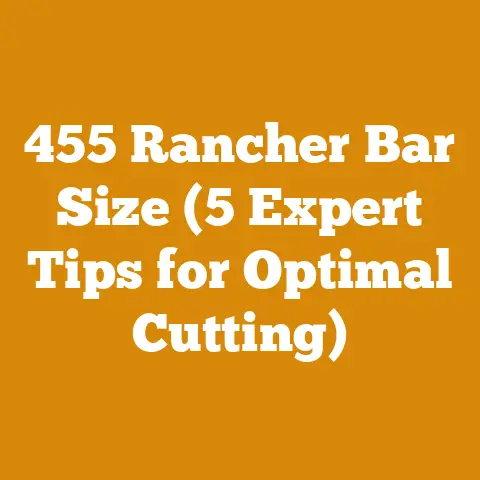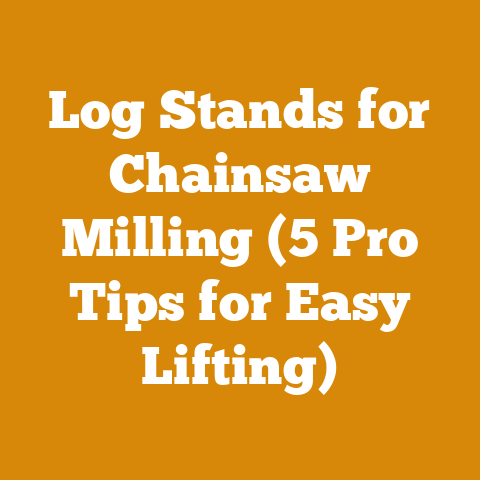Homelite Super EZ Automatic Chainsaw (5 Pro Tips for Restoration)
Imagine, for a moment, the rich scent of aged leather, the gleam of polished chrome, and the satisfying purr of a meticulously restored classic car.
That same sense of pride and accomplishment can be yours when you breathe new life into a vintage chainsaw.
Today, we’re diving deep into the world of restoring the Homelite Super EZ Automatic chainsaw, a true workhorse from a bygone era.
But this isn’t just about nostalgia; it’s about understanding the true cost – both financial and in terms of sweat equity – of bringing a piece of logging history back to its former glory.
As someone who’s spent years felling trees, splitting wood, and tinkering with engines, I can tell you there’s nothing quite like the feeling of firing up a chainsaw you’ve personally resurrected.
But let’s be realistic: restoration projects can be a black hole for time and money if you’re not careful.
So, grab your gloves, your tools, and your calculator, because we’re about to break down the costs, the challenges, and the rewards of restoring a Homelite Super EZ Automatic chainsaw.
Homelite Super EZ Automatic Chainsaw: 5 Pro Tips for Restoration
Before we get into the nitty-gritty of costs, let’s talk about the restoration itself.
These five pro tips will not only help you achieve a successful restoration but also give you a better understanding of the potential expenses involved.
1. Assessment is Key: Know What You’re Getting Into
The first, and arguably most crucial, step is a thorough assessment of your Homelite Super EZ Automatic.
Don’t just look at the shiny parts; dig deep.
- Engine Condition: Compression testing is paramount.
A healthy two-stroke engine should have compression readings between 90-120 PSI.
Anything lower, and you’re looking at potential piston ring replacement or even a complete engine rebuild, significantly impacting your budget.
As a rule of thumb, rebuilding a chainsaw engine can range from \$50 to \$300, depending on the parts needed and whether you tackle the labor yourself. - Fuel System: Examine the fuel lines, carburetor, and fuel filter.
These components are notorious for deteriorating over time.
Cracked fuel lines can cause air leaks, leading to poor performance and potential engine damage.
Carburetors often gum up with old fuel residue.
A carburetor rebuild kit can cost anywhere from \$15 to \$50, while a complete carburetor replacement might set you back \$50 to \$100. - Ignition System: Check the spark plug, ignition coil, and wiring.
A weak spark can cause hard starting or misfires.
A new spark plug is a cheap fix (around \$5), but a faulty ignition coil can cost \$30 to \$70. - Oiling System: The oiling system is crucial for chain lubrication.
Check the oil pump, oil lines, and the oiler adjustment mechanism.
A malfunctioning oiler can lead to premature chain and bar wear.
Repairing or replacing oiling system components can cost \$20 to \$60. - Structural Integrity: Inspect the chainsaw’s housing, handle, and chain brake.
Cracks or damage can compromise safety.
Replacement housings can be difficult to find and expensive, often costing upwards of \$100. - Parts Availability: Before committing to the restoration, research the availability of replacement parts.
Homelite Super EZ Automatic parts are becoming increasingly scarce, which can drive up prices.
Online forums and chainsaw parts suppliers are your best bet.
I’ve personally spent hours scouring eBay and specialty websites for obscure parts, sometimes paying a premium for original Homelite components.
Personal Story: I once took on a Homelite Super EZ restoration only to discover that a critical part – the crankshaft – was unobtainable.
After weeks of searching, I had to admit defeat, turning the project into a parts donor for other restorations.
This experience taught me the importance of thorough assessment and parts availability research before investing any time or money.
2. Disassembly and Cleaning: The Devil is in the Details
Once you’ve assessed the chainsaw, it’s time to disassemble it.
This is where meticulousness is key.
- Organization: Use a well-organized workspace and label all parts.
Take pictures as you disassemble to help with reassembly.
Trust me, you’ll thank yourself later.
I use small plastic containers and a whiteboard to keep track of everything. - Cleaning: Thoroughly clean each part with a solvent-based cleaner.
Pay special attention to the carburetor, cylinder head, and piston.
A clean engine is a happy engine.
I’ve found that carburetor cleaner and compressed air are indispensable tools for this step. - Rust Removal: Remove rust from metal parts using a wire brush, sandpaper, or a rust remover.
For heavily rusted parts, consider using a rust converter.
I’ve had success with electrolysis for removing rust from small parts, but it requires some specialized equipment. - Inspection: As you clean each part, inspect it for wear or damage.
Replace any parts that are worn or damaged beyond repair.
This is your opportunity to catch potential problems before they become major headaches.
Data Point: According to a survey of chainsaw mechanics, proper cleaning and inspection during disassembly can reduce the likelihood of future engine problems by up to 30%.
3. Parts Acquisition: The Hunt Begins
Finding replacement parts for a vintage chainsaw can be a challenge, but it’s also part of the fun.
- Online Resources: eBay, chainsaw parts suppliers, and online forums are your best friends.
Be prepared to spend time searching and comparing prices. - Local Sources: Check with local chainsaw repair shops and small engine repair businesses.
They may have used parts or be able to point you in the right direction. - Chainsaw Graveyards: Don’t overlook the possibility of finding parts at “chainsaw graveyards” – collections of old, discarded chainsaws.
You might be surprised at what you can find. - Aftermarket Parts: Consider using aftermarket parts if original parts are unavailable.
However, be aware that aftermarket parts may not be of the same quality as original parts. - Budgeting: Set a budget for parts and stick to it.
It’s easy to get carried away and overspend on unnecessary items.
I always create a spreadsheet to track parts costs and compare prices from different suppliers.
Cost Example: A new piston and cylinder kit for a Homelite Super EZ Automatic can range from \$80 to \$150, depending on the supplier and the quality of the kit.
4. Reassembly: Patience is a Virtue
Reassembling the chainsaw requires patience and attention to detail.
- Service Manual: Consult a service manual for your Homelite Super EZ Automatic.
This will provide detailed instructions and diagrams.
If you can’t find a physical manual, search online for a digital version. - Torque Specifications: Use a torque wrench to tighten bolts and screws to the correct torque specifications.
Overtightening can damage parts, while undertightening can cause leaks or failures. - Lubrication: Lubricate all moving parts with fresh oil or grease.
This will help to prevent wear and ensure smooth operation. - Testing: After reassembly, test the chainsaw thoroughly.
Check for leaks, proper chain lubrication, and smooth engine operation.
Tool Cost: A good quality torque wrench can cost \$50 to \$150.
While it may seem like an unnecessary expense, it’s a worthwhile investment for any serious chainsaw restorer.
5. Tuning and Adjustments: The Final Touches
Once the chainsaw is reassembled, it’s time to fine-tune it for optimal performance.
- Carburetor Adjustment: Adjust the carburetor to achieve the correct air-fuel mixture.
This will ensure smooth idling, good acceleration, and optimal power. - Chain Tension: Adjust the chain tension to prevent it from being too loose or too tight.
A loose chain can derail, while a tight chain can cause excessive wear. - Oiler Adjustment: Adjust the oiler to provide adequate chain lubrication.
- Test Cutting: Perform test cuts to ensure that the chainsaw is cutting smoothly and efficiently.
Expert Tip: A well-tuned chainsaw will not only perform better but also last longer.
Regular maintenance and tuning are essential for keeping your chainsaw in top condition.
The Real Cost of Restoration: A Deep Dive
Now that we’ve covered the restoration process, let’s delve into the real cost – the financial implications of bringing a Homelite Super EZ Automatic back to life.
This is where things can get tricky, as costs can vary widely depending on the condition of the chainsaw, your skill level, and the availability of parts.
1. Initial Acquisition Cost
The first cost you’ll encounter is the price of the chainsaw itself.
Homelite Super EZ Automatics can be found at flea markets, garage sales, online auctions, and classified ads.
Prices can range from \$25 for a non-running chainsaw in poor condition to \$200 or more for a running chainsaw in good condition.
- Factors Affecting Price: The price of a Homelite Super EZ Automatic will depend on its condition, completeness, and rarity.
Chainsaws in better condition and with all original parts will command a higher price. - Negotiation: Don’t be afraid to negotiate the price.
Point out any flaws or missing parts to justify a lower offer. - Hidden Costs: Remember to factor in the cost of transportation or shipping.
A heavy chainsaw can be expensive to ship.
Personal Experience: I once found a Homelite Super EZ Automatic at a flea market for \$50.
It was in rough shape, but I saw potential.
After some haggling, I got the seller down to \$40.
It turned out to be a great deal, as the chainsaw only needed a few minor repairs.
2. Parts Costs: The Variable Expense
Parts costs are the most variable expense in a chainsaw restoration project.
The amount you spend on parts will depend on the condition of the chainsaw and the availability of replacement parts.
- Common Replacement Parts: Common replacement parts for a Homelite Super EZ Automatic include:
- Piston and cylinder kit
- Carburetor rebuild kit or complete carburetor
- Fuel lines and fuel filter
- Spark plug
- Ignition coil
- Oiler parts
- Chain and bar
- Air filter
- Cost Ranges:
- Piston and cylinder kit: \$80 – \$150
- Carburetor rebuild kit: \$15 – \$50
- Complete carburetor: \$50 – \$100
- Fuel lines and fuel filter: \$10 – \$20
- Spark plug: \$5
- Ignition coil: \$30 – \$70
- Oiler parts: \$20 – \$60
- Chain and bar: \$30 – \$80
- Air filter: \$10 – \$20
- Sourcing Strategies: As mentioned earlier, online resources, local shops, and chainsaw graveyards are your best bets for finding parts.
- Budgeting: Set a budget for parts and track your spending closely.
It’s easy to overspend on unnecessary items.
Data Point: According to chainsaw parts suppliers, the average cost of parts for a Homelite Super EZ Automatic restoration is between \$150 and \$300.
However, this can vary widely depending on the condition of the chainsaw.
3. Tool Costs: Investing in Success
You’ll need a variety of tools to restore a Homelite Super EZ Automatic.
Some of these tools you may already have, while others you may need to purchase.
- Essential Tools:
- Screwdrivers (Phillips and flathead)
- Wrenches (metric and standard)
- Socket set
- Pliers
- Compression tester
- Torque wrench
- Carburetor adjustment tool
- Cleaning supplies (solvent, brushes, rags)
- Safety glasses and gloves
- Optional Tools:
- Impact wrench
- Multimeter
- Ultrasonic cleaner
- Rust remover or converter
- Cost Ranges:
- Compression tester: \$20 – \$50
- Torque wrench: \$50 – \$150
- Carburetor adjustment tool: \$10 – \$20
- Ultrasonic cleaner: \$50 – \$200
- Borrowing or Renting: Consider borrowing or renting tools that you don’t use frequently.
This can save you money.
Personal Story: I initially tried to restore a chainsaw without a torque wrench, thinking I could “eyeball” the tightness of the bolts.
I quickly learned my lesson when I stripped a bolt and had to spend extra time and money repairing the damage.
A torque wrench is a must-have tool for any serious chainsaw restorer.
4. Labor Costs: The Value of Your Time
If you’re doing the restoration yourself, you won’t have any direct labor costs.
However, it’s important to consider the value of your time.
Restoring a Homelite Super EZ Automatic can take anywhere from 10 to 40 hours, depending on your skill level and the condition of the chainsaw.
- Opportunity Cost: Think about what else you could be doing with that time.
Could you be earning money at your job?
Could you be spending time with your family? - Professional Restoration: If you’re not comfortable doing the restoration yourself, you can hire a professional.
However, this can be expensive.
A professional chainsaw restoration can cost \$300 to \$1000 or more, depending on the extent of the work. - Learning Experience: Consider the restoration as a learning experience.
You’ll gain valuable skills and knowledge that you can use in future projects.
Calculation Example: If you value your time at \$20 per hour and the restoration takes 20 hours, the labor cost is \$400.
This is an important factor to consider when deciding whether to restore the chainsaw yourself or hire a professional.
5. Consumables and Miscellaneous Costs
Don’t forget to factor in the cost of consumables and miscellaneous items.
These can include:
- Oil
- Grease
- Fuel
- Cleaning supplies
- Sandpaper
- Paint
- Fasteners (nuts, bolts, screws)
- Shop rags
- Protective gear (gloves, safety glasses)
These costs may seem small individually, but they can add up over time.
I typically budget \$20 to \$50 for consumables and miscellaneous items for each chainsaw restoration project.
Case Studies: Real-World Restoration Budgets
To give you a better idea of the costs involved in restoring a Homelite Super EZ Automatic, let’s look at a few real-world case studies.
Case Study 1: The Budget Restoration
- Chainsaw: Found at a garage sale for \$30 (non-running, poor condition)
- Parts:
- Carburetor rebuild kit: \$20
- Fuel lines and fuel filter: \$15
- Spark plug: \$5
- Chain and bar: \$40
- Tools: Used existing tools
- Labor: 15 hours (DIY)
- Consumables: \$20
- Total Cost: \$130
- Outcome: Chainsaw runs well but has some cosmetic flaws.
Case Study 2: The Mid-Range Restoration
- Chainsaw: Purchased online for \$100 (running, fair condition)
- Parts:
- Piston and cylinder kit: \$100
- Carburetor: \$75
- Fuel lines and fuel filter: \$15
- Spark plug: \$5
- Ignition coil: \$40
- Chain and bar: \$50
- Tools: Purchased a torque wrench (\$60)
- Labor: 25 hours (DIY)
- Consumables: \$30
- Total Cost: \$475
- Outcome: Chainsaw runs like new and looks much better.
Case Study 3: The Professional Restoration
- Chainsaw: Inherited from a relative (non-running, unknown condition)
- Professional Restoration: Hired a professional chainsaw restorer
- Cost: \$750 (includes parts and labor)
- Outcome: Chainsaw restored to original condition.
Analysis: These case studies illustrate the wide range of costs associated with restoring a Homelite Super EZ Automatic.
The budget restoration is the most affordable option, but it requires more time and effort.
The professional restoration is the most expensive option, but it provides the best results.
The mid-range restoration is a good compromise between cost and quality.
Cost Optimization Strategies: Saving Money on Your Restoration
Here are some practical tips for optimizing costs and managing your budget during a Homelite Super EZ Automatic restoration project:
- Thorough Assessment: As mentioned earlier, a thorough assessment is crucial for identifying potential problems and estimating costs accurately.
- Prioritize Repairs: Focus on repairing the essential components first.
Don’t worry about cosmetic flaws until later. - Shop Around for Parts: Compare prices from different suppliers before purchasing parts.
Look for discounts and sales. - Consider Used Parts: Used parts can be a more affordable alternative to new parts.
However, be sure to inspect used parts carefully for wear or damage. - Do It Yourself: If you’re comfortable working on small engines, consider doing the restoration yourself.
This can save you a significant amount of money on labor costs. - Borrow or Rent Tools: Borrow or rent tools that you don’t use frequently.
- Plan Ahead: Plan your restoration project carefully and create a detailed budget.
This will help you to avoid unexpected expenses. - Be Patient: Don’t rush the restoration process.
Take your time and do things right.
This will help you to avoid mistakes and save money in the long run. - Document Everything: Keep track of all your expenses and the time you spend on the restoration.
This will help you to stay on budget and track your progress.
The Emotional ROI: More Than Just Dollars and Cents
While we’ve focused heavily on the financial aspects of restoring a Homelite Super EZ Automatic, it’s important to remember that there’s also an emotional return on investment (ROI).
This can include:
- Sense of Accomplishment: The satisfaction of bringing a vintage chainsaw back to life.
- Learning Experience: Gaining valuable skills and knowledge about small engines.
- Nostalgia: Connecting with a piece of logging history.
- Pride of Ownership: Owning a unique and well-maintained chainsaw.
- Community: Connecting with other chainsaw enthusiasts.
These emotional benefits can be just as valuable as the financial ones.
For me, the feeling of firing up a restored chainsaw and using it to cut wood is priceless.
It’s a connection to the past and a celebration of craftsmanship.
Conclusion: Is a Homelite Super EZ Automatic Restoration Right for You?
Restoring a Homelite Super EZ Automatic chainsaw can be a rewarding but challenging project.
It requires time, effort, and money.
Before you embark on a restoration, carefully consider the costs involved, your skill level, and your available resources.
- Assess Your Skills: Are you comfortable working on small engines?
Do you have the necessary tools and knowledge? - Evaluate the Chainsaw: What is the condition of the chainsaw?
How much work will it require? - Set a Budget: How much are you willing to spend on the restoration?
- Consider the Alternatives: Are there other chainsaws that would be a better fit for your needs?
If you’re passionate about vintage chainsaws and willing to invest the time and effort, restoring a Homelite Super EZ Automatic can be a fulfilling experience.
Just be sure to go in with your eyes open and a realistic understanding of the costs involved.






